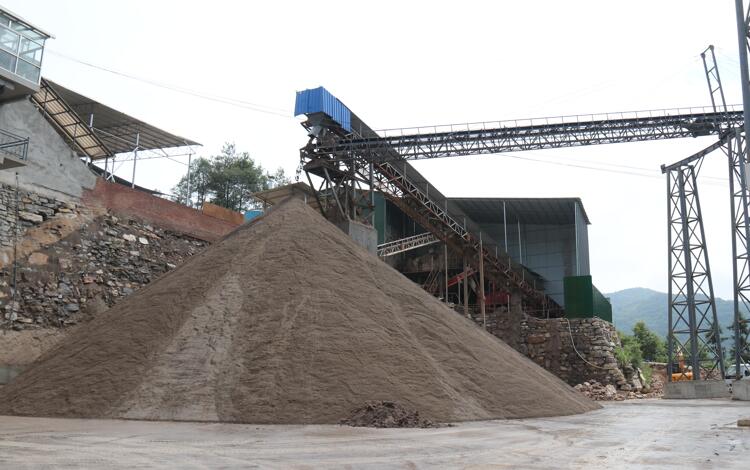
 Xingaonai
Xingaonai

China's annual consumption of sand and gravel aggregate is nearly 20 billion tons, which is the main raw material for infrastructure such as construction, roads, bridges, and hydraulics. The sand and gravel industry has gradually shifted from extensive development to green development.
Currently, the mining of river sand is restricted, and the demand for machine-made sand and gravel is strong. Due to the large mining volume of large-scale mines, the environmental impact is relatively large. To this end, it is imperative to develop green mines while satisfying the requirements of ore resource mining and environmental protection, and achieving a win-win situation of economic benefits and environmental protection.
There is no standard process flow for the dry sand making process. This article takes the floor-type machine-made sand production line as an example to share the differences and characteristics of five green mine dry sand making processes.
1. Current status of dry sand making process
In the last century, my country mainly adopted the wet sand making process. With the improvement of environmental protection requirements, dry sand making technology has gradually become an important technical means for water conservancy project construction. Large-scale water conservancy projects abroad have long promoted dry sand production. In recent years, some hydraulic projects in my country have also adopted this advanced production technology.
The sand making material source of Jinping Hydropower Station project mainly uses marble. Since the marble of Jinping Project has low compressive strength, large softening coefficient and easily turns into powder when hammered, the sand making process of this project mainly adopts the all-dry sand making process. , that is, the vertical shaft sand making machine + powder selection machine-made sand technology, successfully solved the problems of poor gradation of machine-made sand and high stone powder content in Jinping Project. Compared with the wet process, this process consumes significantly less water, does not require the construction of sewage treatment facilities, and does not discharge a large amount of wastewater.
2. Analysis of differences in dry sand making process
In recent years, the mainstream layout of machine-made sand production lines has been floor-type and flat-type.
3. Factors affecting the production effect of dry sand making process
Only by selecting reasonable equipment configuration and layout, adopting appropriate dry sand making process, and comprehensively considering various factors can we ensure the stability and efficiency of the sand making production system. Through comparative analysis of various sand making processes and parent rock lithology, the process influencing factors of machine-made sand quality can be found.
Studying the effects of machine-made sand from different production processes on main indicators such as concrete slump and compressive strength, it is found that the performance of concrete prepared with machine-made sand in dry sand making process is better than that of ordinary processes. Because there are differences in the dry sand making process, there will be differences in quality, output and other result indicators when applying this process technology to produce machine-made sand.
Through experience summary, the main factors affecting the production effect of dry sand making process are as follows:
1) Raw material working conditions.
From the perspective of rock characteristics and compressive strength, consider whether it is soft rock or hard rock, design process and equipment selection; consider the moisture content of raw materials, raw materials with a moisture content of less than 2% are suitable for the dry sand making process.
2) Process design.
Only by studying the construction method can we design a more reasonable process. Generally, the feeding conditions of the dry process are relatively strict, the particle size requirements are relatively small, and the moisture content is low. Generally, it is more suitable for the particle size to be in the range of 0-15mm. If the particle size reaches 0-50mm, the return processing volume will be increased, the output will be reduced, and the wear will be increased.
3) Technical indicators.
Quality indicators such as fineness modulus, powder content, and MB value comply with national or industry standards.
4) Equipment layout.
The layout is divided into floor type (floor type or tower type) and plan type.
5) Equipment selection.
Whether to use a powder separator to remove powder, choose screening equipment such as circular vibrating screens, linear screens, elliptical screens, etc., choose the "stone against iron" and "stone against stone" modes of the sand making machine to adapt to soft rock and hard rock, and consider key equipment performance parameters.
6) Core technology.
Consider optimizing the sand making process from aspects such as powder removal technology, wear-resistant technology, gradation adjustment technology, intelligent control technology and environmental protection technology.
According to the specific conditions of the project, under the guidance of the green development concept, only by adopting the green mine dry sand making process can the win-win effect of economic benefits and environmental protection be achieved to the greatest extent.
Superior: No content!
Abajo: No content!
Nuestros productos se han exportado a más de 170 países de África, Asia, América del Sur, Europa, etc. Estamos aquí para ofrecerle mejores productos y servicios.
Copyright © 2024-2030 Xingaonai Group Todos los derechos reservados. Sitemap